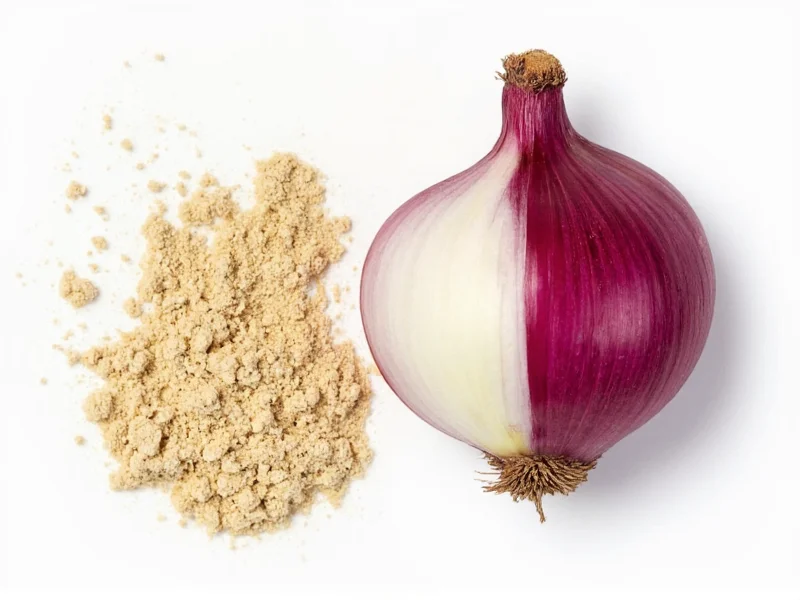The standard conversion is 3 tablespoons (1/4 cup) of onion powder equals 1 medium fresh onion. This ratio works for most recipes, though adjustments may be needed based on onion variety and personal taste preferences.
When substituting onion powder for fresh onions in your cooking, understanding the precise conversion ratio is essential for maintaining recipe balance. Many home cooks and professional chefs face this question when they're out of fresh onions or need a shelf-stable alternative. Getting this measurement wrong can dramatically alter your dish's flavor profile—too little and your recipe lacks depth, too much and it becomes overpoweringly sharp.
Understanding Onion Powder Conversion Ratios
Onion powder provides concentrated onion flavor without the moisture of fresh onions, making it valuable for spice blends, dry rubs, and recipes where liquid content matters. The standard conversion ratio of 3 tablespoons (1/4 cup) of onion powder to 1 medium fresh onion (about 5 ounces or 140g) serves as your foundational guideline. This measurement assumes a medium yellow onion, the most common variety used in cooking.
| Onion Size | Fresh Onion Weight | Onion Powder Equivalent |
|---|---|---|
| Small | 3-4 oz (85-115g) | 2 tablespoons |
| Medium | 5 oz (140g) | 3 tablespoons (1/4 cup) |
| Large | 6-8 oz (170-225g) | 1/4 cup + 1 tablespoon |
| Jumbo | 8+ oz (225g+) | 1/3 cup |
Factors That Affect Onion Powder Substitution
Several variables influence how much onion powder equals one fresh onion in your specific recipe:
Onion Variety Differences
Yellow onions (most common in recipes) have a stronger flavor than sweet varieties like Vidalia. When substituting for sweet onions, reduce the powder by 25% to avoid overpowering your dish. For red onions used raw in salads, consider using only half the standard amount since their sharpness intensifies when dehydrated.
Moisture Content Considerations
Fresh onions are approximately 89% water, while onion powder contains virtually no moisture. In recipes where liquid content matters—like sauces, soups, or baked goods—you may need to adjust other liquid ingredients when making the substitution. For every medium onion replaced, consider reducing other liquids by 1-2 tablespoons.
Powder Concentration Variations
Not all onion powders are created equal. Some brands use higher concentration levels during dehydration. If using a particularly potent brand, start with 2.5 tablespoons per medium onion and adjust to taste. Always check the label for any concentration information that might affect your conversion.
Practical Application in Cooking
Knowing how much onion powder equals 1 onion is just the beginning—understanding when and how to use this substitution makes the difference between a good dish and a great one.
Best Uses for Onion Powder
Onion powder shines in applications where:
- Dry spice rubs for meats (no moisture to prevent browning)
- Commercial food production (consistent flavor, longer shelf life)
- Emergency cooking when fresh onions aren't available
- Recipes requiring uniform flavor distribution
- Situations where onion texture would be undesirable
When to Stick with Fresh Onions
Certain dishes simply don't translate well to powder substitution:
- Fresh salsas and salads (texture is essential)
- Caramelized onion applications (different Maillard reaction)
- Dishes where visual onion pieces matter
- Recipes specifically designed around fresh onion's moisture content
Pro Tips for Successful Substitution
Professional chefs employ several techniques when replacing fresh onions with powder:
Rehydration Method
For recipes where moisture matters, mix your measured onion powder with 2-3 tablespoons of warm water and let it sit for 5-10 minutes before adding to your recipe. This partially recreates the fresh onion's texture and distributes flavor more evenly.
Layered Flavor Approach
Combine 2 tablespoons onion powder with 1 teaspoon onion juice (from grated fresh onion) for a more complex flavor profile that bridges the gap between powder and fresh.
Taste-As-You-Go Principle
Always add onion powder gradually, especially in delicate dishes. The flavor intensifies as your dish cooks, so it's better to under-season initially and adjust near the end of cooking.
Storage and Shelf Life Considerations
One advantage of knowing the onion powder conversion ratio is understanding how to extend your cooking capabilities. Properly stored in an airtight container away from light and moisture, onion powder maintains peak flavor for 2-3 years—significantly longer than fresh onions' 1-2 month shelf life. This makes it an excellent pantry staple for unexpected recipe needs.
Common Substitution Mistakes to Avoid
Even experienced cooks sometimes misjudge the onion powder to fresh onion ratio. Watch out for these pitfalls:
- Overcompensating for moisture loss - Don't add extra liquid equal to the onion's water content
- Ignoring recipe timing - Add powder earlier in cooking than fresh onions for full flavor development
- Using inconsistent measurements - Always level your tablespoons; don't heap them
- Forgetting about salt content - Some onion powders contain added salt; adjust seasoning accordingly











 浙公网安备
33010002000092号
浙公网安备
33010002000092号 浙B2-20120091-4
浙B2-20120091-4